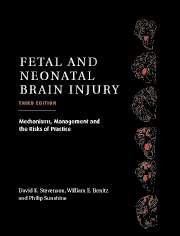Book contents
- Frontmatter
- Contents
- List of contributors
- Foreword
- Preface
- Part I Epidemiology, Pathophysiology, and Pathogenesis of Fetal and Neonatal Brain Injury
- 1 Perinatal asphyxia: an overview
- 2 Mechanisms of brain damage in animal models of hypoxia–ischemia in newborns
- 3 Cellular and molecular biology of perinatal hypoxic–ischemic brain damage
- 4 Fetal responses to asphyxia
- 5 Congenital malformations of the brain
- 6 Prematurity and complications of labor and delivery
- 7 Intrauterine growth retardation (restriction)
- 8 Hemorrhagic lesions of the central nervous system
- Part II Pregnancy, Labor, and Delivery Complications Causing Brain Injury
- Part III Diagnosis of the Infant with Asphyxia
- Part IV Specific Conditions Associated with Fetal and Neonatal Brain Injury
- Part V Management of the Depressed or Neurologically Dysfunctional Neonate
- Part VI Assessing the Outcome of the Asphyxiated Infant
- Index
- Plate section
3 - Cellular and molecular biology of perinatal hypoxic–ischemic brain damage
from Part I - Epidemiology, Pathophysiology, and Pathogenesis of Fetal and Neonatal Brain Injury
Published online by Cambridge University Press: 10 November 2010
- Frontmatter
- Contents
- List of contributors
- Foreword
- Preface
- Part I Epidemiology, Pathophysiology, and Pathogenesis of Fetal and Neonatal Brain Injury
- 1 Perinatal asphyxia: an overview
- 2 Mechanisms of brain damage in animal models of hypoxia–ischemia in newborns
- 3 Cellular and molecular biology of perinatal hypoxic–ischemic brain damage
- 4 Fetal responses to asphyxia
- 5 Congenital malformations of the brain
- 6 Prematurity and complications of labor and delivery
- 7 Intrauterine growth retardation (restriction)
- 8 Hemorrhagic lesions of the central nervous system
- Part II Pregnancy, Labor, and Delivery Complications Causing Brain Injury
- Part III Diagnosis of the Infant with Asphyxia
- Part IV Specific Conditions Associated with Fetal and Neonatal Brain Injury
- Part V Management of the Depressed or Neurologically Dysfunctional Neonate
- Part VI Assessing the Outcome of the Asphyxiated Infant
- Index
- Plate section
Summary
Perinatal cerebral hypoxia–ischemia (asphyxia) typically is initiated by compromised placental or pulmonary gas exchange, leading to systemic hypoxia/anoxia with or without concurrent acidosis (asphyxia). Hypoxia/hypercapnic acidosis increases cerebral blood flow (CBF) to an extent which is adequate to maintain cerebral oxidative metabolism stable until cerebral ischemia supervenes owing to cardiac depression with secondary bradycardia and systemic hypotension. With the cerebral oxygen and substrate (glucose) debt arising from ischemia, oxidative metabolism shifts to anaerobic glycolysis with its inefficient generation of high-energy phosphate reserves necessary to maintain cellular ionic gradients and other metabolic processes. Ultimately, cellular energy failure occurs, which, in association with other processes, ultimately results in death of the tissue.
Over the past several years, a wealth of basic and clinical research has expanded our knowledge of those critical cellular and molecular events which eventually lead to brain damage arising from hypoxia–ischemia. Investigations have shown that hypoxia–ischemia sets in motion a cascade of biochemical alterations that are initiated during the course of the insult and proceed well into the recovery period after resuscitation (reperfusion injury). This chapter will highlight those cellular and molecular processes involved in this metabolic cascade and how they evolve into perinatal hypoxic–ischemic brain damage.
Cellular energy transformations
Adenosine triphosphate (ATP) is the primary energy modulator of essentially all cells within the body, including neurons and glia. Its two ~P exists at an energy level capable of providing the necessary driving force for innumerable biochemical reactions and physiologic processes.
- Type
- Chapter
- Information
- Fetal and Neonatal Brain InjuryMechanisms, Management and the Risks of Practice, pp. 58 - 82Publisher: Cambridge University PressPrint publication year: 2003
- 1
- Cited by



